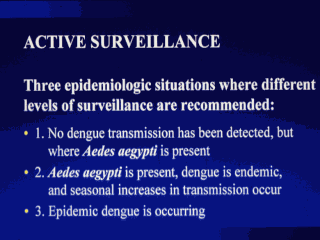|
|
|
|
front |1 |2 |3 |4 |5 |6 |7 |8 |9 |10 |11 |12 |13 |14 |15 |16 |17 |18 |19 |20 |21 |22 |23 |24 |25 |review |
 |
In summary, an effective dengue surveillance system must address the disease from both a clinical and an entomological perspective as well as consider the virologic, epidemiologic, and serologic aspects that are useful in an active surveillance system: Clinical Surveillance: surveillance for viral syndromes with a fatal outcome may be more effective in providing an early warning of epidemic activity; Entomologic Surveillance: surveillance which deals with dengue's mosquito vectors, requires knowledge of the species present, species associations, species distributions, the types and productivity of larval habitats, seasonal changes in population densities, and behavior of the principal vector involved; Epidemiologic Surveillance: the aim of epidemiologic surveillance is to monitor disease activity for dengue-like illness and/or dengue hemorrhagic fever/dengue shock syndrome. Serologic Surveillance: When used in conjunction with epidemiologic case reporting, routine serologic surveillance data are very useful in determining what proportion of cases actually involves dengue. There are three epidemiologic situations where different levels of surveillance are recommended: 1. Countries where no dengue transmission has been detected, but where Aedes aegypti is present. 2. Countries where Aedes aegypti is present, dengue is endemic, and seasonal increases in transmission occur. 3. Areas where epidemic dengue is occurring. |